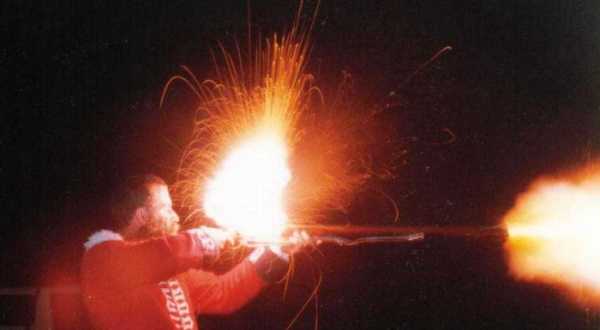Firing and Cleaning a Flintlock
 The flintlock works like this. When the cock or hammer falls, the flint strikes the steel "frizzen" and knocks it open. The flint shaves tiny pieces of steel from the frizzen. Friction between the two heat these tiny pieces RED HOT and they fall onto the
powder in the pan. The powder ignites and the HEAT from this flash ignites the charge in the barrel through the "vent" or touch-hole in the barrel.
The flintlock works like this. When the cock or hammer falls, the flint strikes the steel "frizzen" and knocks it open. The flint shaves tiny pieces of steel from the frizzen. Friction between the two heat these tiny pieces RED HOT and they fall onto the
powder in the pan. The powder ignites and the HEAT from this flash ignites the charge in the barrel through the "vent" or touch-hole in the barrel.
This vent is next to the pan, and it required frequent cleaning with a wire "pick". The flint was re-sharpened from time to time. This was called "Knapping" or "picking" the flint. Eventually the
flint wore out, after 60 to 80 shots. Flints could be replaced easily in the field with a "turn screw".
You can see why it was important to carry spare flints at all times. A dull flint or damp powder resulted in a "misfire" (the rifle failed to fire at all).
The first time you see a flintlock fired, it's spectacular with all the sparks, smoke and noise. If you've watched the Sharpe films, you've seen real flintlocks in action.

Thanks to Peter for these notes, and to Sol and John of the 42nd Royal Highland Regiment 1815 Australia Ltd for the chance to illustrate them.
Go to The Flintlock
Return to The Baker Rifle
Return to Main Page
Content Copyright © 2002, 2003 Susan H Law and her licensors. All rights reserved.
Last update 12/2/03
 The flintlock works like this. When the cock or hammer falls, the flint strikes the steel "frizzen" and knocks it open. The flint shaves tiny pieces of steel from the frizzen. Friction between the two heat these tiny pieces RED HOT and they fall onto the
powder in the pan. The powder ignites and the HEAT from this flash ignites the charge in the barrel through the "vent" or touch-hole in the barrel.
The flintlock works like this. When the cock or hammer falls, the flint strikes the steel "frizzen" and knocks it open. The flint shaves tiny pieces of steel from the frizzen. Friction between the two heat these tiny pieces RED HOT and they fall onto the
powder in the pan. The powder ignites and the HEAT from this flash ignites the charge in the barrel through the "vent" or touch-hole in the barrel.